I have never baked a gluten-free bread before. Neither my husband nor I do have celiac disease. And truth be told, I don’t know much about baking gluten free. But when Amy Chaplin, who is one of my favorite vegan/vegetarian chefs, posted this recipe on her blog I was intrigued.
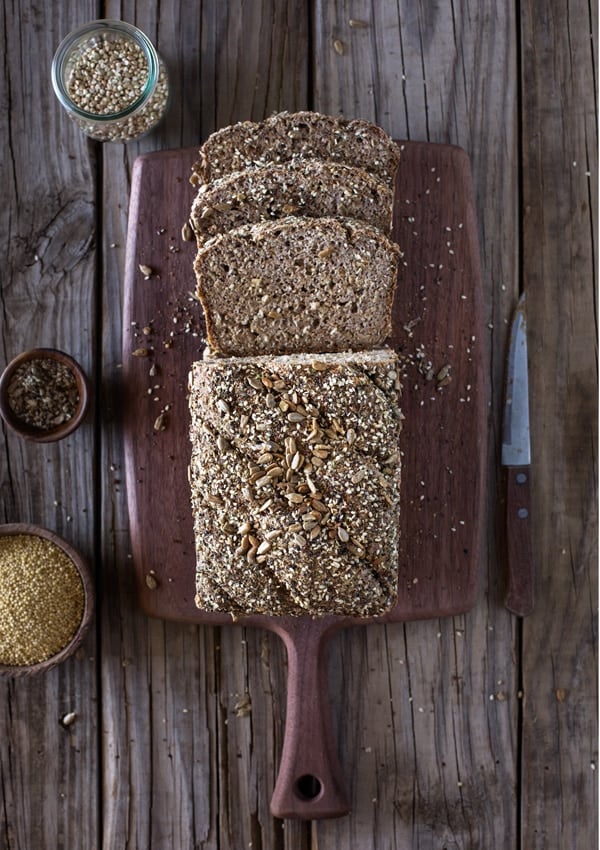
To be honest, I wanted to read more about it not because it was gluten-free, but because it was made with using millet and buckwheat (both of which are super healthy grains) instead of all-purpose flour. Even though there are many similar bread recipes out there on the Internet, I usually have a hard time figuring out where to start when it comes to baking bread using ancient grains.
But when she posted this recipe, I knew that it would be a good one to start with. Luckily as suspected, it didn’t disappoint. This bread is so easy to make, even for someone like me, who is learning her way around the world of vegan/gluten-free baking. It also is foolproof.
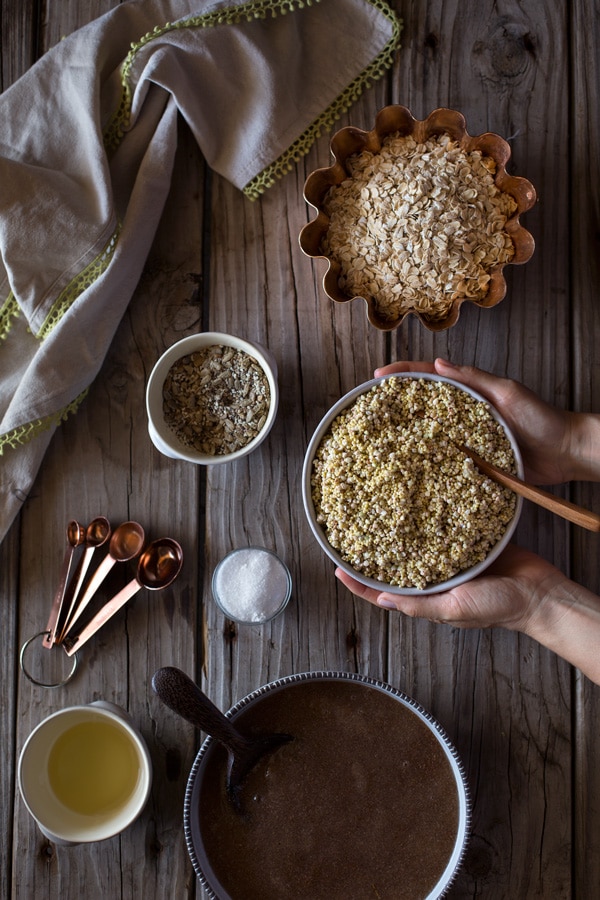
To make it, in addition to millet and buckwheat Amy uses an ingredient called psyllium seed husk (or also called psyllium husk). The first time I read about psyllium husk was a year ago, when David and Luise of Green Kitchen Stories posted a recipe called Cashew Rawgurt. It was basically yogurt made with cashews instead of milk.
They used psyllium husk to give it a creamy consistency that was similar to the consistency of yogurt. But then, more and more I read about gluten-free and healthy baking ingredients, I realized that it is a much more of a common ingredient than I thought.
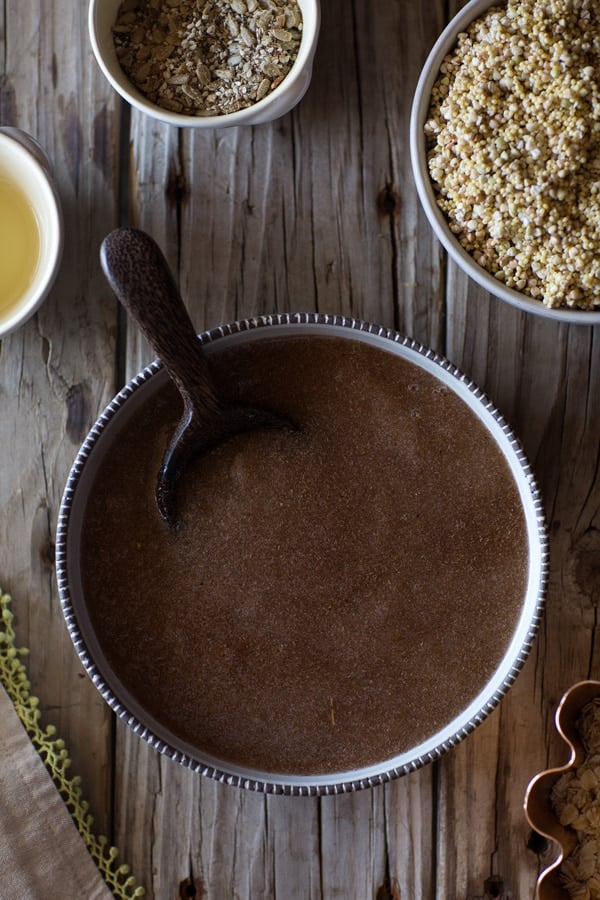
After some research and surfing through the Internet, I found out that psyllium husk (the photo above is what it looks like after it was mixed with water):
- Is a natural source of soluble fiber that doesn’t include wheat, and therefore it is gluten-free.
- Has multiple health benefits, because when mixed with liquids it turns into gel, which acts like a sponge and absorbs toxins in the digestive tract. Because of this reason, people with constipation and irregularity issues are advised to incorporate it into their diets.
- Is used in gluten-free baking, because due to its gel-like structure (when mixed with water/liquida), it acts like gluten giving body to baked goods. It is mostly used when baking gluten-free bread, pizza dough, rolls, pasta, etc.
- Is sold in the gluten-free baking section of the supermarkets as either in capsules or in powder form. (This recipe uses the powder form. In particularly, this brand.)
With all that being said, there are many resources on the Internet cautioning people as some allergic reactions to pysllium husk have been recorded. Therefore, if this is your first time consuming it, I recommend trying in a small dose before using it to bake bread.
You could also do what I did; simply add a tablespoon of it in a smoothie (another popular way of incorporating it into your diet) to see if you react to it in a negative way. Luckily, both my husband and I were totally fine after we drank our smoothies.
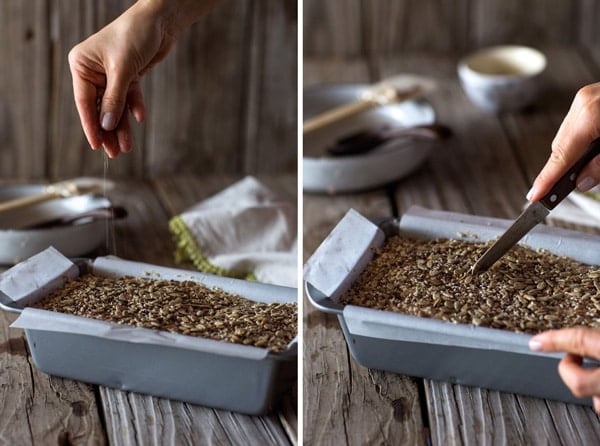
About This Millet Buckwheat Recipe
In her blog post, Amy posted a halved version of this recipe. However, she suggested that it would be fine to double it, which is what I did. To make the dough, you use a food processor. If you have a regular 9-cup food processor like mine, you may find that when all the ingredients are placed in it, it may look like it is too much. For this reason, on my first try I made two separate batches, mixed them in a bowl, and then baked them together.
But on my second try (which is the bread in the photos), I placed everything in the food processor at the same time. It was quite full, but I stopped every 8-10 seconds to scrape the bowl during the process to make sure that everything is mixing evenly. Either way, they both turned out nicely. So it is totally up to you and your preference. Also if you want, you can half the recipe for a smaller loaf.
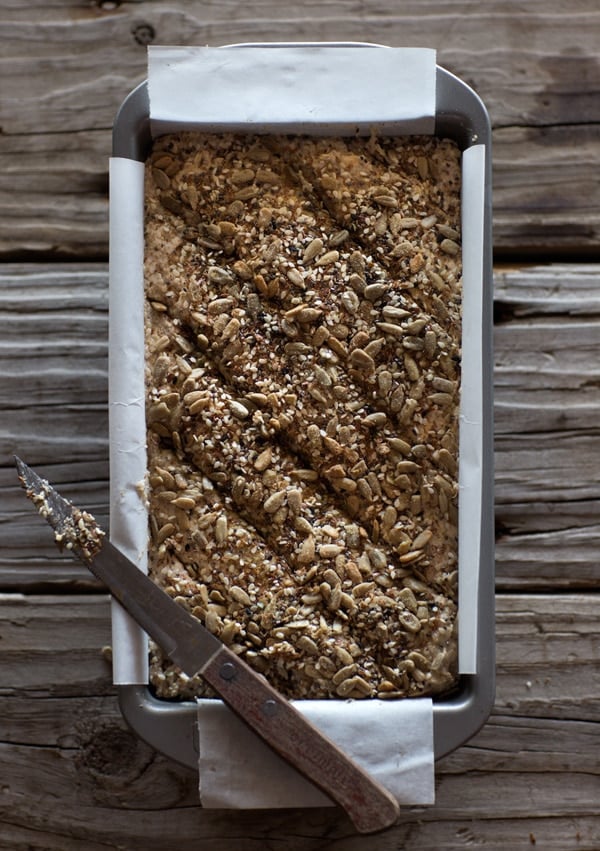
On a final note, it is imperative to score the bread twice- once before it goes into the oven and an additional time after it has been baking for 40 minutes. Doing so lets some air into the dough for it to cook properly. Since it is better to score it in the same place, I suggest sprinkling it with the seeds prior to scoring it for the first time. That way when it is time for you to score it again you can easily see the marks.
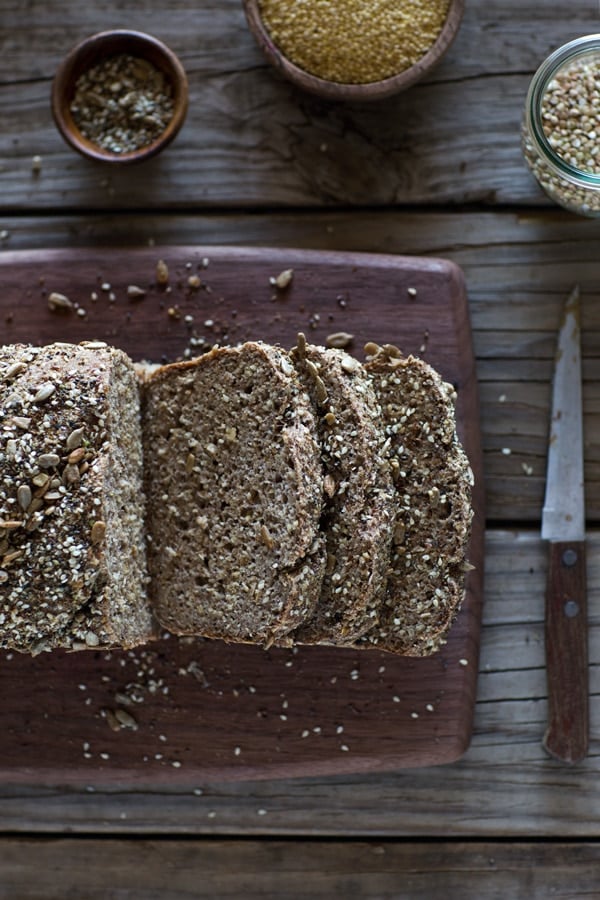
Other Gluten-Free Recipes You Might Be Interested In
- Almond-Kasha Porridge with Ginger and Pineapple
- Overnight Coconut Buckwheat Porridge
- Sorghum Pilaf with Lentils, Feta, and Grapes
- Creamy Mushroom Pasta with Fresh Peas and Ricotta
- Gluten-Free Almond Flour Bread
- Need more inspiration? Check out all our bread recipes

Millet and Buckwheat Bread
Ingredients
- 1 cup buckwheat groats
- 1 cup millet
- 3 cups filtered water
- 1/2 cup psyllium whole husks (I used Yerba Prima brand), 1.5 oz.
- 1 1/2 + 1 cups, (9 oz.) rolled oats, divided (Gluten-free type)
- 2 tablespoons baking powder
- 2 teaspoons sea salt
- 4 tablespoons walnut, coconut or olive oil would work too oil
- 2 teaspoons ground flax seeds
- 2 teaspoons chia seeds
- 2 teaspoons toasted sesame seeds
- 2 teaspoons sunflower seeds
Instructions
- Place buckwheat groats and millet in a large bowl. Pour enough water to cover at least 2 inches from the top. Allow it to soak for 10 hours or overnight.
- Pre-heat the oven to 350 degrees. Line a 9X5 loaf pan with parchment paper. Set aside.
- Drain the buckwheat and millet combination in a strainer. Rinse well and set aside. (Buckwheat will be slimy so it is important to wash it well.)
- Place psyllium whole husks in a bowl and add the 3 cups of water. Mix and set aside. 5-10 minutes should be enough.
- Place rinsed buckwheat groats, millet, and 1 1/2 cups oats in the bowl of a food processor. Process until completely combined and grains are almost completely broken down, 45-50 seconds. You may have to scrape the bowl 1 or 2 times.
- Add in the soaked pysllium husks, rest of the oats, baking powder, sea salt, and oil in the bowl of a food processor. Process until everything is combined, 30-45 seconds. Make sure to stop and scrape the bowl a couple of times.
- Transfer the dough into the prepared loaf pan. Spread it out using the back of a spatula.
- Combine flax, chia, sesame, and sunflower seeds in a bowl.
- Sprinkle half of the seeds on top of the bread. Using a sharp knife, score the top of the loaf in several places. (For a visual, see the photo above)
- Sprinkle the rest of the seeds and place it in the pre-heated oven.
- Bake for 40 minutes. Remove and re-cut the places you scored earlier to let some of the air in for the inside of the bread to fully bake. Return it to the oven and bake for 55-60 minutes or until a knife inserted in the middle comes out slightly sticky.
- Let it cool for 15 minutes on the kitchen counter and remove it from the pan.
- Before slicing it, allow it to come to the room temperature.
- You can store it in an airtight container for up to 4 days at room temperature or up to a week in the fridge.
Nutrition
Nutrition information is automatically calculated, so should only be used as an approximation.
This recipe is adapted from Amy Chaplin’s Gluten-Free Millet and Buckwheat recipe.
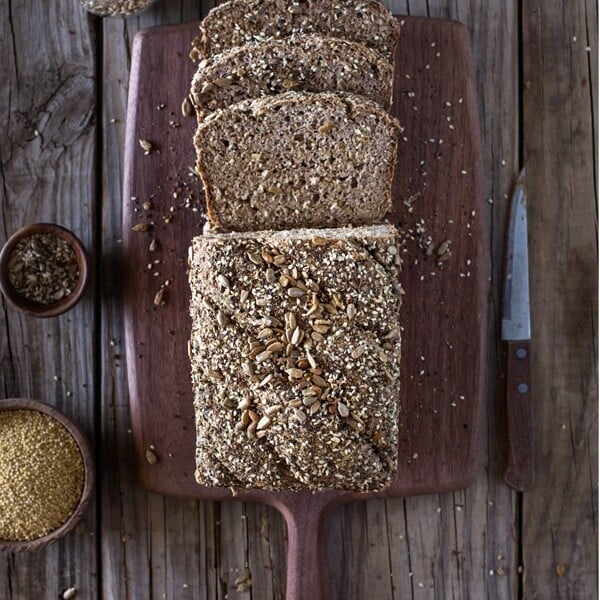

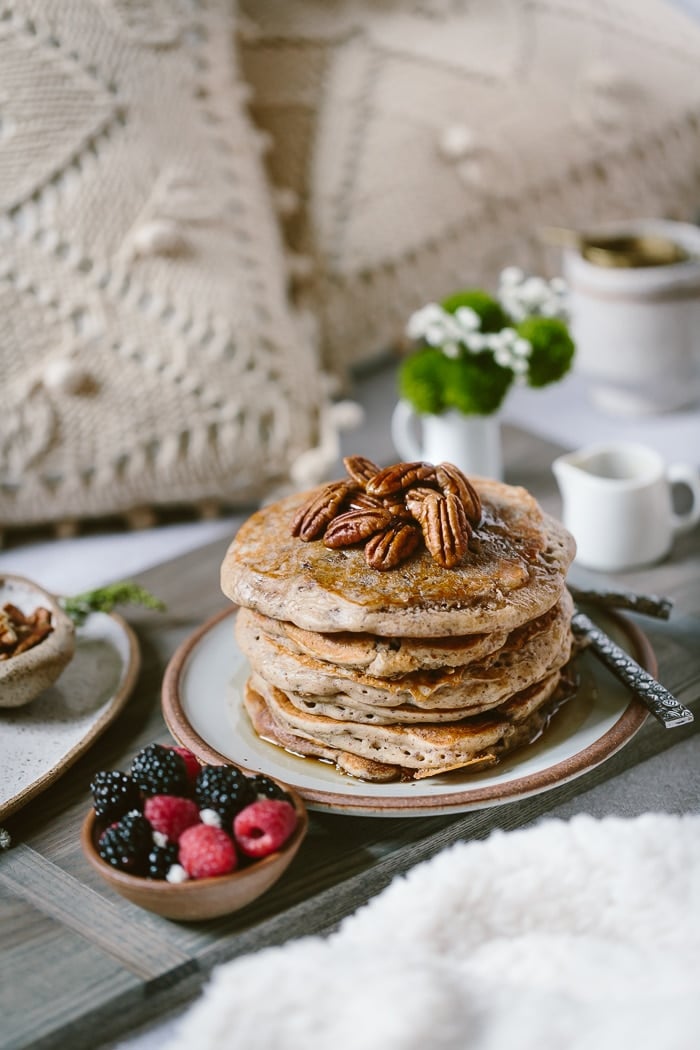
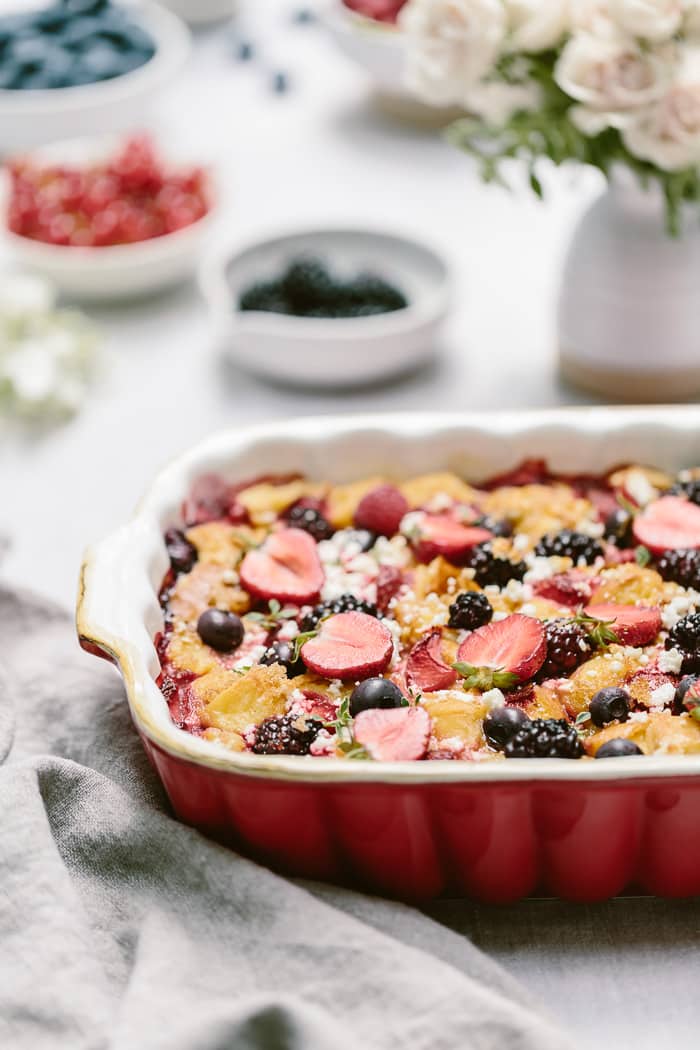
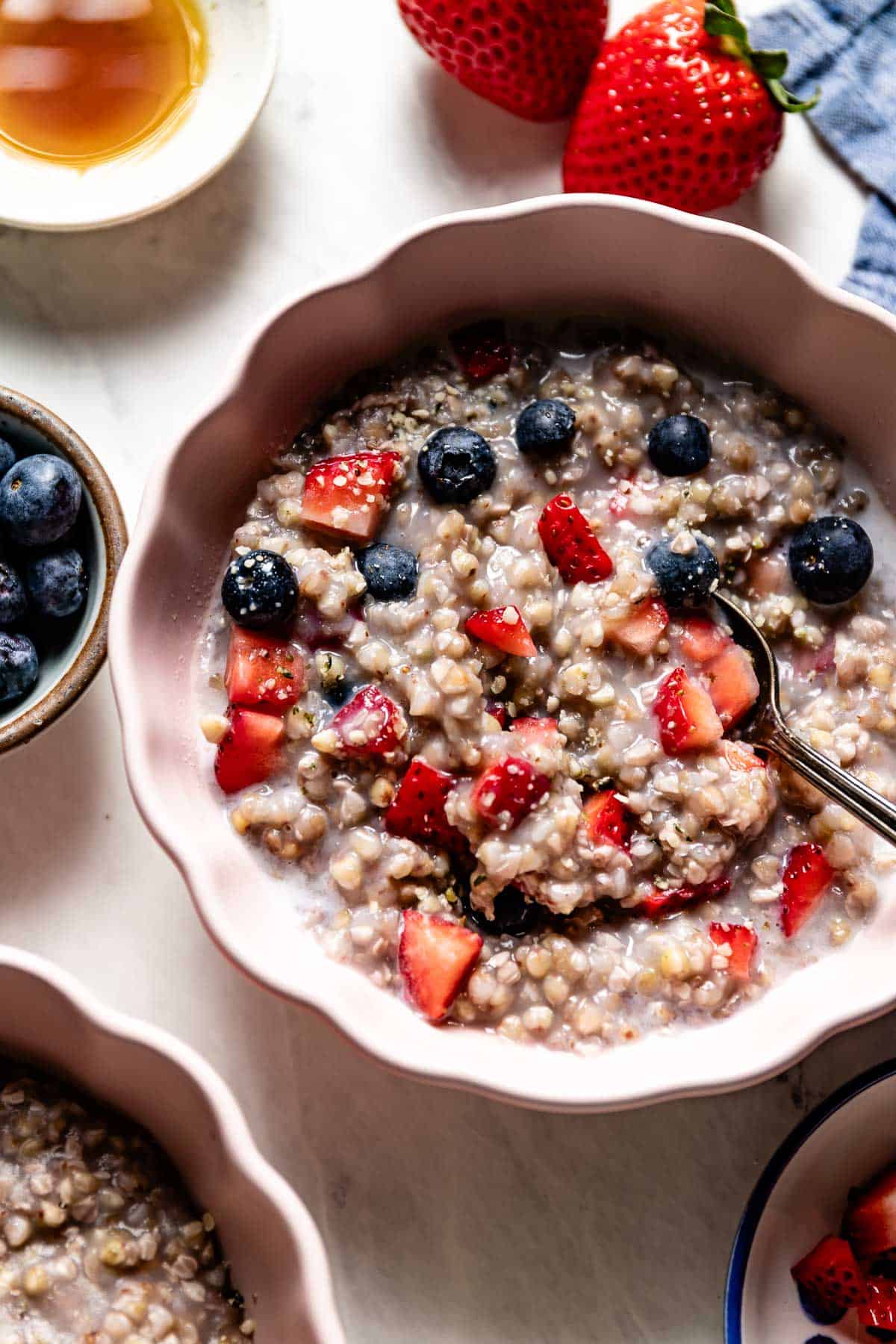
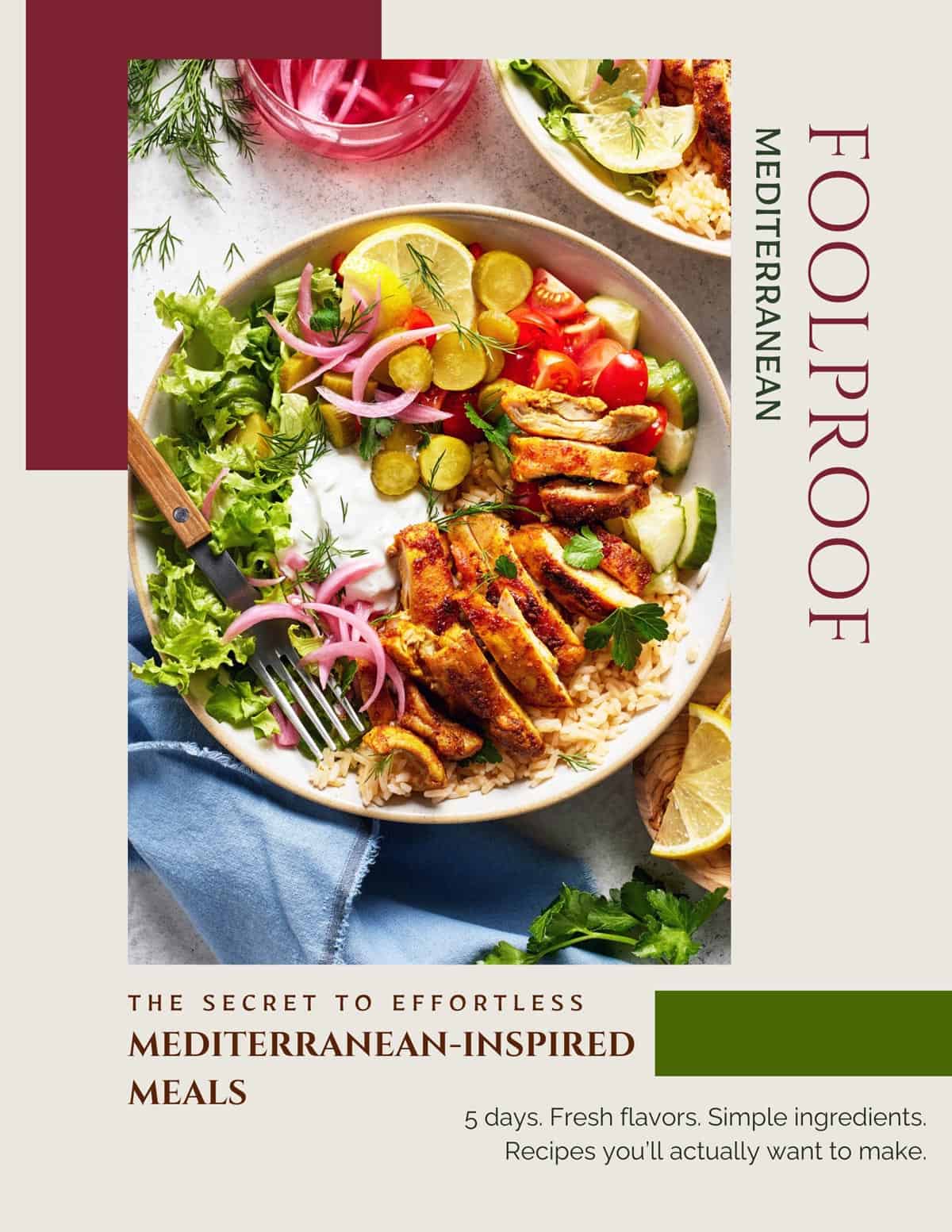









I’ve been making this bread regularly, and have some data to report. 🙂
Firstly, once I forgot to put in the coconut oil, and it turned out just as well; I only remembered later, and then tried it without oil again to make sure, and it was indeed still good. In case anyone wishes to try this bread with reduced or even no oil.
Secondly, I have made a banana bread out of it and it is so, so delicious. I took 4 very ripe bananas, mashed them up as finely as I could, and replaced some of the water with them – it turned out to be about 2 cups of mashed bananas, so I added a third cup of plain water, and then the psyllium husks as usual. The dough wasn’t as elastic and super sticky, and the resulting bread was softer, but still held together perfectly well. I didn’t add anything to sweeten it because I like to spread something sweet on top anyway, like honey or maple butter; but I’m sure a tablespoon or two of honey in the water would do no harm for those who want their banana bread sweet.
The banana flavour almost if not wholly removes the buckwheat taste, of which some people were not fans in my experience. I’m excited to have them try it again.
Also, in the food processor for the first step with buckwheat, millet, and 1 1/2 cups of oats, I processed them pretty finely and scraped down the sides multiple times. In the end, it comes out feeling just like a moist banana bread; I think people wouldn’t even be able to tell that it’s gluten free or made with anything “weird”.
Olga! WOW! This is such great information. Thank you so much for sharing it with all of us.
I just ran out of psyllium husks, but as soon as I get some I will try your banana version.
THANKS again!
So I finally made the bread yesterday, using raw buckwheat and regular rolled oats, and it is so delicious! The texture is great, and I like it even more than regular wheat/flour bread because it’s so moist. Also it holds together very well, so you can cut very thin slices without it falling apart. My two year old daughter loved it, and so did my mother and grandmother who were visiting. My husband said he didn’t like it because of the flavour, but I suspected that he had cut off a piece that was way too thick, so I cut him a thin slice, and spread some coconut butter, almond butter, and honey on it, and he changed his mind. 🙂 This will be a staple in our home.
Hey Olga,
It is so nice to hear from you. I thought about you yesterday and wondered if you had a chance to make it yet.
So glad that you and your family liked it. It is a favorite in our house as well.
Thank you so much for letting me know.:)
Ice
I just started an elimination diet to determine whether my daughter is gluten intolerant, and I am so excited about trying this recipe. It looks likes the pinnacle of nutrient-dense, healthy bread. And it’s so simple too! Without the seeds on top (some of which we have allergies to), it’s only a few basic ingredients, and I love that.
I’m about to order some GF oats for it online, and I had a question: would QUICK rolled oats also work? I’d prefer them to just regular rolled oats, unless you think it is important to have the regular whole-looking ones. Thanks!
Hi Olga,
Yes, this bread is delicious and healthy.
To be honest, I have never tried making it with quick rolled oats. I usually use either Trader Joe’s’ Gluten-free ground oats or Quaker Oats ground oats. Like I mentioned, I have never tried it, but I think it would be better to stick to the regular oats.
Let me know how it turns out. If you have any other questions feel free to let me know.
Cheers!
Thanks!
Another question is: are your buckwheat groats roasted, or unroasted? The ones I have at home seem more brown than the ones in your photos. Would either work?
Hi Olga,
I am assuming what you have is kasha (aka toasted buckwheat). It would still be good, but taste a little different. So the answer to your question is yes. I’d say make it with kasha for this time. Next time try it with buckwheat groats.
Hope this helps. Let me know how it turns out.
Best of luck!
would love to make this – but I only have psyllium husk powder – how much would I use?
Hey there..
Though I have never tried making this bread with psyllium husk powder, based on this link (http://healthyeating.sfgate.com/better-psyllium-seed-powder-psyllium-husk-whole-12248.html) 1 tablespoon of psyllium husk is equal to 1 teaspoon of powder.
Since 1 cup is equal to 16 tablespoons, it would be 16 teaspoons.
Like I mentioned earlier, I have never tried it with powder but I think it should be fine.
I hope this helps.
Please let me know how it turns out.
Thanks!
Hello,
I love making bread with psyllium husks and different grains and seeds, and the use of buckwheat and millet makes this one look especially tasty! Thanks for sharing. I just have one ingredient question. You mention ground oats for two parts. Should I put regular oats in with the buckwheat and millet when they get processed, or should I already have the oats ground? Are the oats that get mixed in with the husks also supposed to be ground? Should I measure the oats before or after grinding?
Thanks for any answers! Can’t wait to make it.
Hi Anne,
I do love making bread with psyllium husks, grains, and seeds. I see why it was confusing. You can use regular rolled oats and place them in the food processor with buckwheat groats and millet at the same time. No need to grind them in advance. Same goes for the second addition.
I hope this clarifies it. Please let me know if I can answer any other questions.
Cheers!
Thanks so much! I’ve got it in the oven right now. Can’t wait!
Just an update to say that I have made a LOT of bread with recipes similar to this, but this one was hands down the very best. I’m so glad I tried it. Thank you!
Aww thank you Anne. I am so glad you liked it. It is one of my favorites too.
Thanks again so much for the note. Cheers!
This is the absolute best healty whole grain GF bread! Thankyou! I can’t wait to try a sweet version –
I’m going to sub 1/4 cup maple syrup for water , use coconut oil for the fat & add raisins.
Oh yes!! Sweet version.. I have to try it too. I can only imagine how great it will taste with the maple syrup addition.
Thanks so much for letting me know Rae. 🙂
Hi!
this bread looks awesom. I am going to make it, just have a question : what can I substitute the phsyllium with? I just cannot seem to find it in my country..
thank you!
Hi There Shirka,
This bread is truly great, but unfortunately the “magic” ingredient is phsyllium husk. I really do not know what else you can substitute it with. Not sure where you are but have you tried ordering it in amazon.com?
This bread looks so incredible and I bet the avocado on top makes it the perfect breakfast (I love that video btw!!). Can’t wait to try this version!
Thank you Sarah!
I have neither made GF bread, nor used any buckwheat/millet in my dish. To tell you the truth, I am a bit scared. Though this bread looks incredible, and it changes my mind a bit about (maybe) trying it. 🙂
Love the vdo, Aysegul
<3 <3 <3 the post
I was the same way Pang, but there is nothing to be scared of. It is so easy to make and it is hard to believe that something that tastes this good could be healthy for you!
Thank you for your kind comments about the video.
Cheers!
Has anyone tried freezing this bread? I would love to make several loaves at once and bring it camping!
Hi Emma,
You can freeze this bread. I recommend letting it fully come to room temperature before you do so. I also recommend slicing it before you freeze.
I hope this helps.
Thank you fo this post, it is great!
Alnis
http://alnisfescherblog.com
Thank you Alnis!